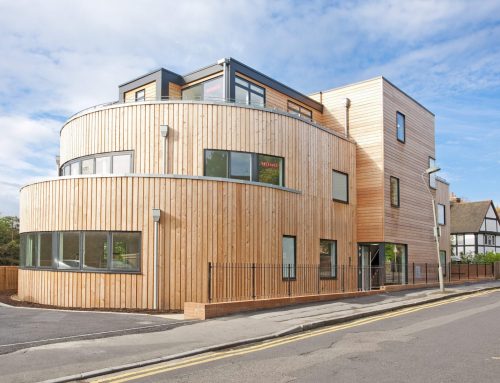What is a Passive House?
Passive House is a fabric first building approach with super insulated walls, floor and roof and also air tight requiring only a minimal amount of heating. Most of the heating requirement is provided by solar gain and incidental gains from showering, cooking and appliances.
A passive house is designed to have minimal energy requirements for space heating and cooling and have excellent indoor air quality making it extremely comfortable to live in.
A passive house not only has lots of insulation, but careful detailing to eliminate thermal bridging that allows heat to transfer directly through building junctions or gaps in insulation. A passive house must also achieve a very strict level of air tightness to remove heat loss through draughts. Fresh air is then supplied to individual rooms in the house through a heat exchanger, transfering heat energy from the warm, damp stale air extracted from kitchens and bathrooms.
The Passivhaus standard originated in Germany in 1996 and was developed by the Passivhaus Institut (PHI). Gaining Passivhaus certification is not a requirement to building a low energy home but shows that there has been independent verification that a house meets the passive principals.
Its great advantage is that it eliminates the performance gap between designed and built performance. The build is checked and measured against the designed proposal and signed off by an independent certifier.
Advantages of a Passive House
How we can help
We can support support clients on their journey to designing a low energy home using Passive House principles. We are able to help both at the early pre-planning stages with design principals and design reviews and also after planning if you already have a house design completed.
We recognise that clients will come with differing experience of the design and build process and are likely to require varying levels of support. As such clients can use our services as much or little as they require to ensure a smooth Design and Build process.
We regularly work with Architects and Architectural technicians at all stages of the design process, advising on Passive House principals, details and producing PHPP models.
We advise on all aspects of low energy and sustainable building processes, including:
- Design review and advice for low energy buildings and retrofits. Passive House, EnerPhit retrofit, AECB buildingstandards, LETI retrofit standard.
- Guiding self-builders through the design, planning and build process
- Passivhaus design (PHPP) modelling
- Embodied carbon calculations and comparisons for different build types
- Technical detailing
- Interior design, finishes specification, lighting and electrical layouts
- Recommendation on preferred suppliers
- Recommendation on sustainable materials
- Tendering and post-tender analysis
- Help with production of documentation for building control
- Contractor support, training and quality control
- Project management
Passive House Design and PHPP modelling
PHPP (Passive House Planning package) is a tool used to model all aspects of a buildings design to assess how it will perform once constructed.
We can build a model even at the early pre planning stages of the design to inform on its likely performance and help with the design process. This can then be modified over time once further details construction methods and specifications have been decided on.
Modelling a design in PHPP is not just for clients looking to certify a building as Passive House. It is a great tool to inform on potential space heating loads and to review overheating risks which can potentially happen in any new build or retrofit. It can help direct the selection of construction techniques and insulation requirements for walls, roofs, windows etc.
Passive House principals and PHPP modelling are also used for the AECB building standards as well as the LETI retrofit standard, but each has its own slightly varying target criteria.
If you are interested in building to a certified level of Passive House we can assist and work with an approved certifier to gain certification of the project.
Passive House design and self build
Award winning design and self build of a Passive standard super insulated low energy 5 bedroom family home on the edge of Guildford. A detailed blog of the project can be found here.











